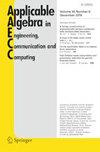循环码低命中区跳频序列集的构造
IF 0.6
4区 工程技术
Q4 COMPUTER SCIENCE, INTERDISCIPLINARY APPLICATIONS
Applicable Algebra in Engineering Communication and Computing
Pub Date : 2022-09-19
DOI:10.1007/s00200-022-00581-4
引用次数: 0
摘要
在准同步通信系统中,具有最佳汉明相关性的低命中区跳频序列(LHZ-FHS)集是理想的选择。在本文中,我们首先从纠错码文献中著名的辛格尔顿约束(Singleton bound)推导出 LHZ-FHS 集的最大非非凡汉明相关性的新约束,然后从循环码中获得 LHZ-FHS 集的一般构造。特别是,从穿刺里德-所罗门码中构造了两类符合新约束的 LHZ-FHS 集。本文章由计算机程序翻译,如有差异,请以英文原文为准。
Constructions of low-hit-zone frequency hopping sequence sets from cyclic codes
Low-hit-zone frequency hopping sequence (LHZ-FHS) sets having optimal Hamming correlation are desirable in quasi-synchronous communication systems. In this paper, we first derive a new bound on maximum nontrivial Hamming correlation of LHZ-FHS sets from the famous Singleton bound in error correcting code literature, then obtain a general construction of LHZ-FHS sets from cyclic codes. Especially, two classes of LHZ-FHS sets meeting the new bound are constructed from punctured Reed-Solomon codes.
求助全文
通过发布文献求助,成功后即可免费获取论文全文。
去求助
来源期刊
CiteScore
2.90
自引率
14.30%
发文量
48
审稿时长
>12 weeks
期刊介绍:
Algebra is a common language for many scientific domains. In developing this language mathematicians prove theorems and design methods which demonstrate the applicability of algebra. Using this language scientists in many fields find algebra indispensable to create methods, techniques and tools to solve their specific problems.
Applicable Algebra in Engineering, Communication and Computing will publish mathematically rigorous, original research papers reporting on algebraic methods and techniques relevant to all domains concerned with computers, intelligent systems and communications. Its scope includes, but is not limited to, vision, robotics, system design, fault tolerance and dependability of systems, VLSI technology, signal processing, signal theory, coding, error control techniques, cryptography, protocol specification, networks, software engineering, arithmetics, algorithms, complexity, computer algebra, programming languages, logic and functional programming, algebraic specification, term rewriting systems, theorem proving, graphics, modeling, knowledge engineering, expert systems, and artificial intelligence methodology.
Purely theoretical papers will not primarily be sought, but papers dealing with problems in such domains as commutative or non-commutative algebra, group theory, field theory, or real algebraic geometry, which are of interest for applications in the above mentioned fields are relevant for this journal.
On the practical side, technology and know-how transfer papers from engineering which either stimulate or illustrate research in applicable algebra are within the scope of the journal.

 求助内容:
求助内容: 应助结果提醒方式:
应助结果提醒方式:


